09 Jan Landscaping To Improve Clay Soil
Struggling with the soil in your garden? Here are some tips on landscaping to improve clay soil.
Many of the gardens we work with have clay soils. And I won’t lie – it’s not always an easy medium to work with. Particularly in new build gardens where the soil has been abused by the builders. When clay is compacted it turns into a sludgy mess that won’t even grow weeds, let alone anything else.
However, if you understand what makes clay soil sticky in winter and rock hard in summer, then you can start to put together a strategy for landscaping to improve clay soil.
Sticky clay soil on a landscaping site – when finished, this garden went on to win a prestigious APL award, proving that clay soils can be managed if you understand how to work with them.
Improving Clay Soil – The Science Bit.
Any soil is made up of trillions of minute particles of minerals and organic matter with countless microbial life forms living amongst them. The proportions of each component are what determines the look and feel of the soil and how different plants will interact with it. I guess it’s a bit like cake. Whatever type of cake you’re trying to make, the basic ingredients are the same. Fat, sugar, flour, egg and flavourings. Get the balance right and you’ll have a light, airy delicious sponge. Too much of one thing or not enough of another and you could end up with anything from a soggy pancake to (in my case) a crunchy concoction.
When you are landscaping to improve clay soil, you need to start with a thorough understanding of the proportions of particles within it.
Discovering what’s in your soil
The 3 basic ‘ingredients’ of soil are clay, silt and sand. And by measuring the proportions of each, you’ll be able to decide which type of soil you have. A very simple way of measuring is to half fill a glass jar with soil from your garden. Just soil – no roots, twigs or leaves. Now add tap water until the level reaches about 2cm from the top of the jar. Put the lid on, give it a really good shake and then leave it for a couple of hours. The soil components will separate out and settle into different layers. Biggest (heaviest) particles at the bottom and smallest particles at the top.
This is how scientists classify soil particles.
- Clay: Less than 0.002mm in diameter
- Silt: Between 0.002mm and 0.05mm
- Sand: 0.05mm – 2mm diameter
- Stones: Bigger than 2mm
You probably won’t have the means (or the will!) to measure the particles in your pot – but you will be able to see the layers and estimate what percentage of your soil is clay, silt, sand or stones.
Use the chart below to decide which type of soil you are working with. For example, if your garden soil contains 50% clay, 40% silt and 10% sand, you can classify it as ‘silty clay’. In fact, any soil with over about 25 % clay particles is classed as clay. The higher the percentage clay, the more ‘interesting’ it will be to work with.
Another clue to whether you are working with sandy or clay soils is to scrunch up some damp soil up in your hand. It should form a ball. Now poke the ball with your finger. If it falls apart easily, it’s sandy. If it retains its shape, it’s most likely to be clay.
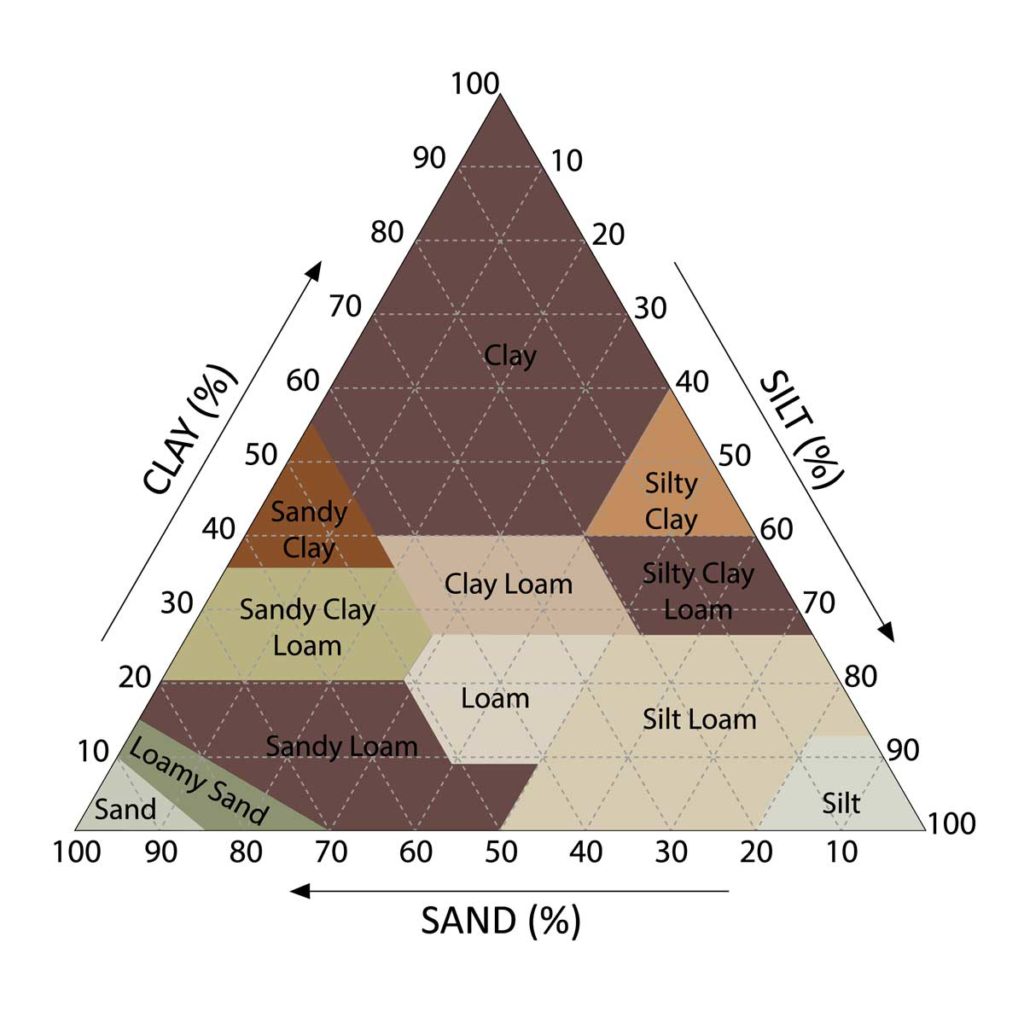
Why Soil Spaces Are More Important Than The Components
For the purposes of landscaping, it’s not the chemical composition of soils that matter as much as the spaces in between the particles. When the plan is to have a nice friable soil to grow plants in, it’s really important to have spaces between the soil particles. That’s so that water can filter through to the plants’ roots and so that air can circulate. As well as mineral content, soil contains a myriad of minuscule life forms that help to store carbon and nurture the plants. They all need air and water too.
In clay soils, the particles are not only tiny, they’re actually flat too and kind of sticky. Which means that once they’re squished together, there’s not a lot of room between the particles for air or water to circulate. That’s bad news for plants and mini beasts. When water does get in, the molecules can’t run freely through the soil and away into the watercourses. It gets trapped – which is what makes clay soil so poorly drained.
Compacted clay soil is bad news for landscapers too, because a huge number of soil particles squished into a small space is very dense. Dense = heavy as anyone who has ever tried to dig a clay based veg patch will be able to testify.
The size and shape of clay particles also means that when clay soil is damp, the particles slip and slide over each other like slime. Trust me, it’s horrible to work with. In summer all the clay particles stick fast to each other and when the water trapped in the soil finally evaporates you get great big clumps of hard baked, impenetrable soil. It’s not nice to look at, and if I were a plant or an earthworm, I certainly wouldn’t fancy living in it.
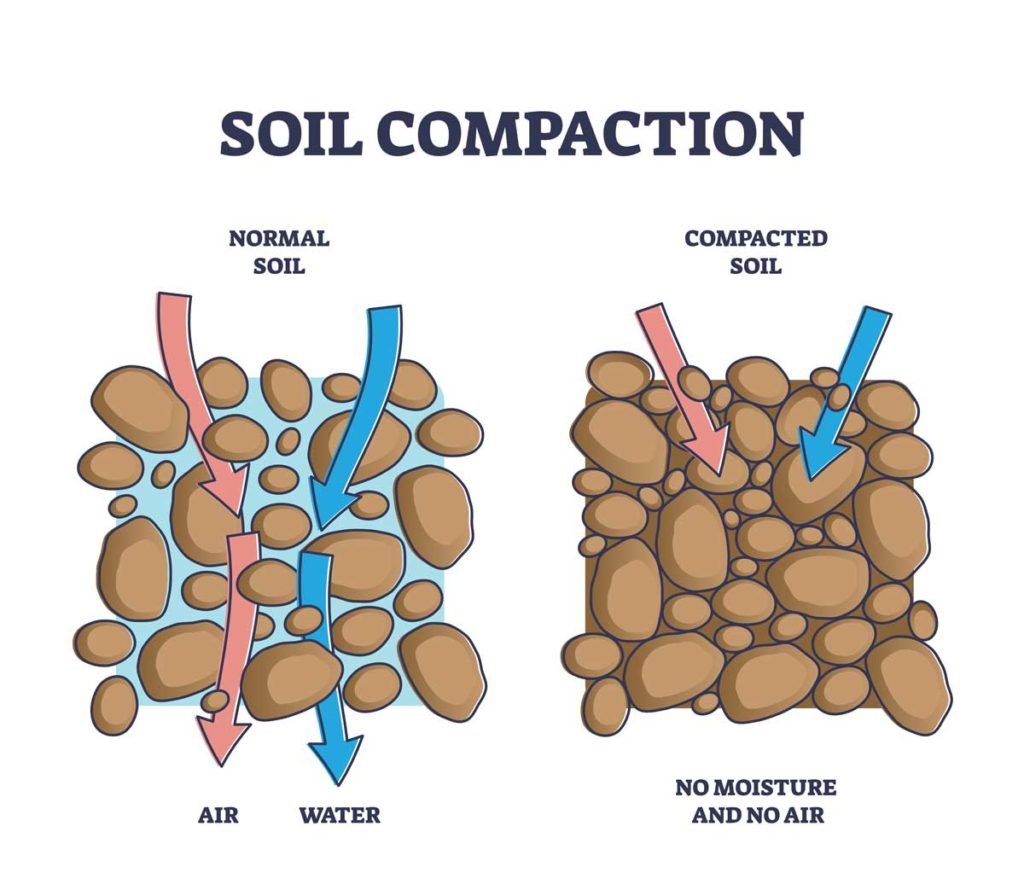
How To Improve Clay Soil With Landscaping
Now that we know what causes the problems with clay soil, we can figure out how to solve them. Basically, what’s needed is to introduce more space between those particles. That way water and air can circulate so that plants and mini beasts can thrive.
The good news is, that you do have choices.
My first choice of action when faced with heavy clay soil is to remove as much of it as possible and replace it with a good quality topsoil. In my experience, that’s the quickest and most effective method. Unfortunately, it’s also the costliest, especially if you need to hire skips to take away the waste.
You could design your garden so that it is a mix of hard landscaping and raised beds. And yes, you can raise a lawn area. That way you can add a layer of aggregate to help with drainage before bringing in a more loamy kind of topsoil.
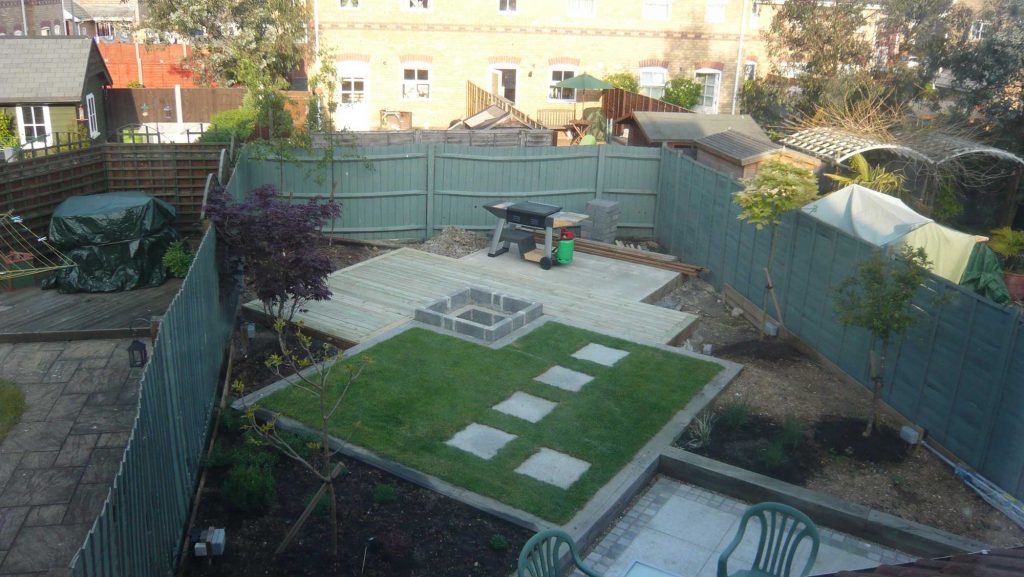
This garden on heavy clay was built on a limited budget. To save the cost of taking waste away from the site, we raised the lawn and imported good soil to support the grass, then we incorporated lots of organic matter into the planting beds to improve the growing medium.
Some landscapers like to install land drains. They’re certainly an option and well worth looking into for managing excess water. They’ll not help relieve compaction in the long term though. Neither will they stop the soil becoming desperately dry in summer.
Another method used when landscaping to improve clay soil is to dig in lots and lots of organic matter. I’m pretty sure this is how gardeners have been managing clay soil for – oh – centuries. And really, it IS nature’s way. If man didn’t have farms or gardens, there’d be a constant supply of fallen leaves and animal dung added into the soil. It’s the cycle of life.
Here’s the thing with the cycle of life, things go awry when it’s broken. Over time, the soil microbes will break down organic matter into plant food. And then the plants will use it all up. So to perpetuate the cycle, we need to keep up the supply of organic material by mulching and/or manuring. If you want a lower maintenance garden therefore, replacing clay soil will be an easier option for you.
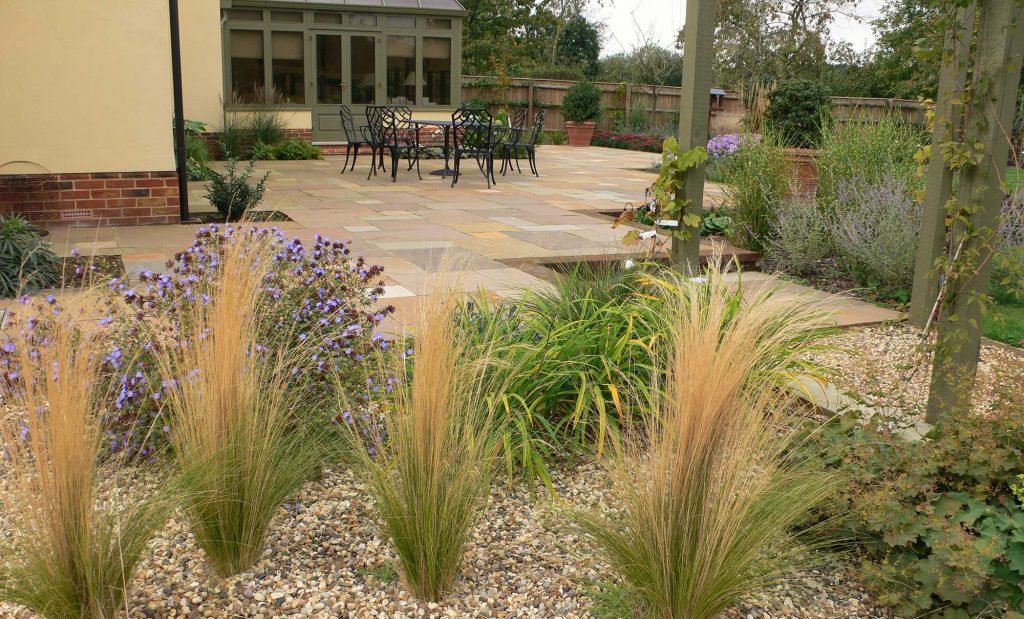
One way to deal with clay soil is to incorporate lots of aggregate and then mulch with even more gravel.
With careful construction and the right choice of plants it can become a very attractive low maintenance feature.
Are You Fed Up With Managing Clay Soil In Your Garden?
Don’t worry, you’re not the only one. Clay soil is sticky and messy in winter, dry and ugly in summer and it restricts the way you can use your garden. It’s well worth investing in landscaping to improve clay soil – you’ll find it makes your life a lot more pleasant. You’ll be able to use your garden all year round. Grow your favourite plants, have a nice lawn and entertain outdoors without worrying about the massive cracks in your lawn.
Talk to Holland Landscapes about improving the clay soil in your garden.
How to make the most of a wet garden https://www.hollandscapes.co.uk/how-to-make-the-most-of-a-wet-garden/
What does £25K buy you in landscaping? https://www.hollandscapes.co.uk/what-does-25000-buy-you-in-landscaping/



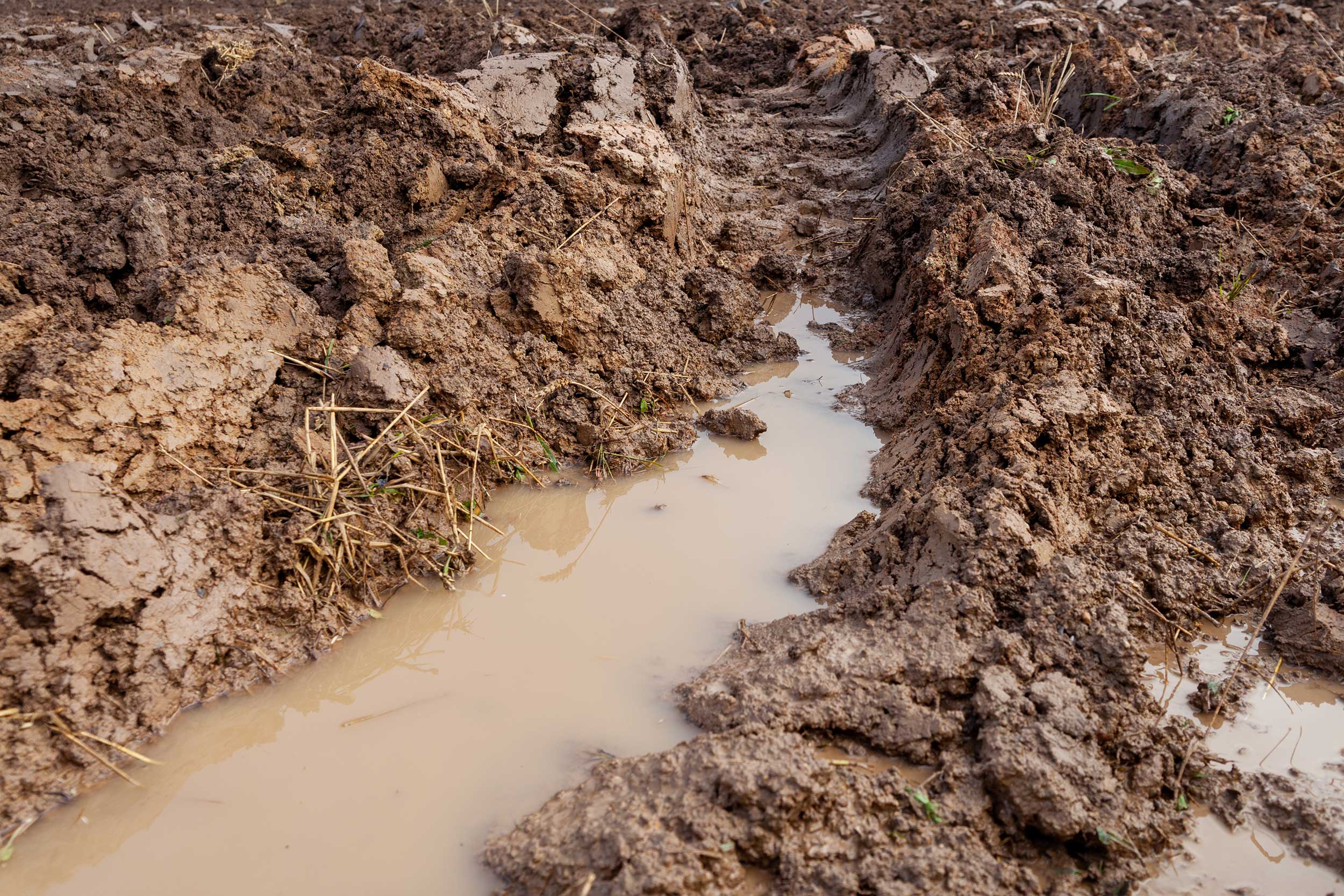
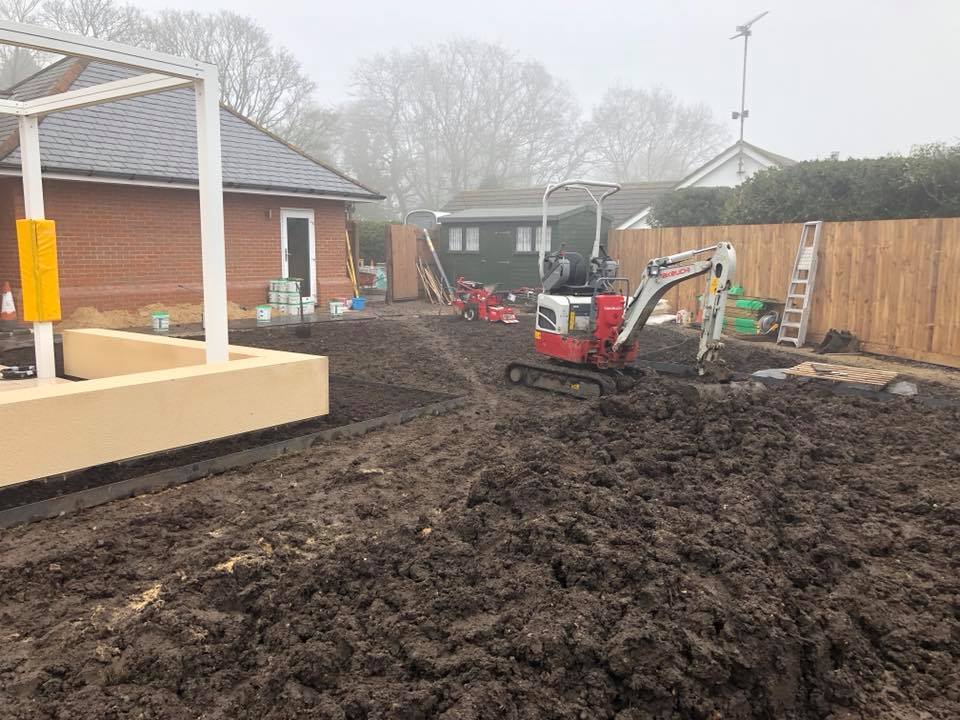
Sorry, the comment form is closed at this time.